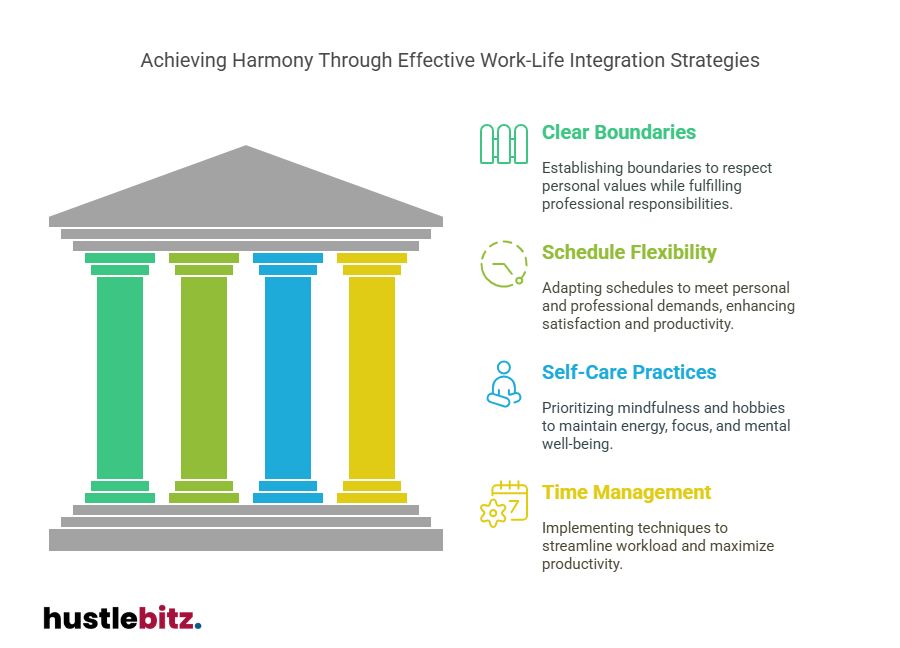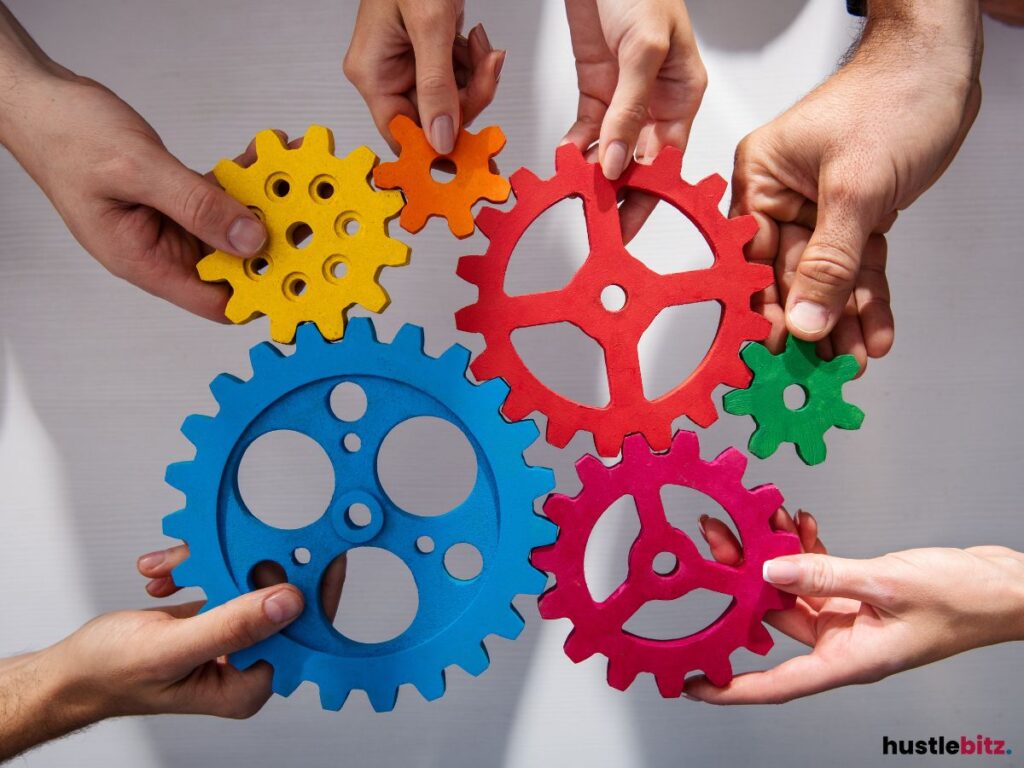Achieving work-life integration involves seamlessly blending personal and professional responsibilities. Key strategies include establishing clear boundaries and prioritizing self-care to enhance overall well-being. Flexibility in scheduling is crucial, enabling adaptation to various demands. Embracing remote work facilitates a balance by allowing individuals to manage their time effectively. Effective time management techniques, such as time blocking and priority mapping, help streamline tasks and minimize distractions. A personal action plan aligns goals with aspirations while enabling continuous reflection and adjustment. Discovering additional methods to enhance your work-life integration can lead to sustainable balance and fulfillment.
Key Takeaways
- Establish clear boundaries to respect personal values while fulfilling professional responsibilities for a harmonious work-life integration.
- Embrace flexibility in schedules to adapt to personal and professional demands, enhancing overall satisfaction and productivity.
- Prioritize self-care through mindfulness practices and hobbies to maintain energy, focus, and mental well-being.
- Implement effective time management techniques, such as time blocking and priority mapping, to streamline workload and maximize productivity.
- Create a personal action plan that aligns professional goals with personal aspirations, ensuring accountability and regular progress tracking.

Understanding Work-Life Integration

Work-life integration refers to the seamless blending of personal and professional responsibilities, allowing individuals to navigate their commitments more fluidly. This approach fosters work-life harmony, where both realms complement rather than compete against each other. It encourages individuals to establish clear boundaries that respect their personal values while meeting professional demands.
Adopting a holistic approach to work-life integration involves recognizing the significance of family connections and emotional well-being. By prioritizing relationships and self-care, individuals can enhance their overall satisfaction, leading to greater career satisfaction as well. Role flexibility plays a crucial part in this integration, allowing individuals to shift between personal and professional roles without sacrificing one for the other.
To support this transition, productivity strategies become essential. These strategies help in managing time and resources effectively, fostering an environment where lifestyle adjustments can be made comfortably. For instance, adopting flexible work hours or remote work options can significantly improve work-life integration, allowing for greater adaptability to changing circumstances.
Ultimately, achieving work-life integration is about creating a life where professional obligations and personal aspirations coexist harmoniously. It is a continuous journey that requires regular reflection and adjustments to maintain balance. By focusing on core values and fostering meaningful connections, individuals can cultivate an enriching environment that enhances both their personal and professional lives.
This integrated approach not only boosts productivity but also nurtures emotional resilience, paving the way for a fulfilling career and life.
The Importance of Flexibility
Flexibility is a crucial component of work-life integration, as it enables individuals to adapt their schedules and commitments to better align with both personal and professional demands. In today’s fast-paced environment, the ability to implement flexible schedules is increasingly recognized as essential for fostering a healthy balance between work and home life. Organizations that embrace adaptive strategies in their workplace policies can significantly enhance employee satisfaction and productivity.
For instance, the integration of remote collaboration tools allows teams to work effectively, regardless of their physical location. This adaptability is particularly beneficial during career transitions, where individuals may need to juggle new responsibilities or personal commitments. By accommodating diverse family dynamics, organizations can support employees in maintaining personal boundaries, ultimately leading to improved mental health and well-being.
Moreover, an organizational culture that prioritizes flexibility encourages employees to explore productivity tools that enhance their workflow, thereby increasing efficiency. When employees feel empowered to customize their work hours and environments, they are more likely to engage deeply with their tasks, leading to higher levels of creativity and output.
Prioritizing Self-Care

Prioritizing self-care is essential for maintaining overall well-being and ensuring sustained productivity in both personal and professional spheres. In today’s fast-paced world, neglecting self-care can lead to burnout, diminished mental health, and a decline in physical wellness. Establishing effective self-care routines is a crucial step toward nurturing both body and mind.
Incorporating mindfulness practices such as meditation and deep breathing can enhance stress management capabilities, allowing individuals to navigate daily challenges with greater resilience. It’s important to recognize personal boundaries to avoid overcommitting to work or social obligations, which can deplete energy reserves. Engaging in hobbies and interests that bring joy and satisfaction can also serve as a vital counterbalance to daily pressures.
Building and maintaining support networks is another significant aspect of self-care. Connecting with friends, family, or colleagues fosters an environment of encouragement and understanding, essential for mental health. Additionally, implementing a digital detox can reduce overstimulation and promote clearer thinking, allowing for more effective self-reflection exercises that help individuals identify their needs and aspirations.
Ultimately, prioritizing self-care is not a luxury but a necessity. By making intentional choices to prioritize their well-being, individuals can enhance their overall quality of life, leading to improved productivity and a more harmonious integration of work and personal responsibilities. Embracing self-care is a proactive strategy that empowers individuals to thrive in all aspects of their lives.
Embracing Remote Work Opportunities

The rise of remote work opportunities has significantly transformed how individuals can balance their professional responsibilities and personal lives, offering greater autonomy over their schedules and environments. This shift has been facilitated by the development of remote collaboration tools that enhance digital communication strategies, allowing teams to remain connected irrespective of geographical boundaries.
A well-structured home office setup is crucial for productivity and comfort. Establishing work boundaries becomes essential to avoid the blurring of lines between work and personal time. By adopting asynchronous work practices, employees can manage their tasks flexibly, catering to their peak productivity hours while contributing to a more inclusive remote work culture.
Additionally, virtual team building activities play a vital role in fostering camaraderie among colleagues, which can be challenging in a remote setting. Organizations are increasingly recognizing the importance of employee well-being initiatives, ensuring that team members feel supported and engaged despite physical distance.
However, the transition to remote work is not without its challenges; technology integration challenges can arise, particularly for teams unaccustomed to relying on digital platforms. To navigate these obstacles, professionals can utilize online productivity hacks to maximize efficiency and maintain focus.
Embracing remote work opportunities not only contributes to individual well-being but also offers organizations the chance to cultivate a resilient, adaptive workforce. As remote work continues to evolve, prioritizing these strategies will be key to achieving a harmonious work-life integration.
Effective Time Management Techniques
Implementing effective time management techniques is essential for professionals seeking to enhance productivity and achieve a balanced work-life integration. By employing strategies such as time blocking, individuals can allocate specific time slots for tasks, ensuring focused work periods free from distractions. This method complements task batching, wherein similar tasks are grouped together, allowing for a more streamlined approach to workload management.
Priority mapping is another crucial technique; it enables professionals to identify and rank tasks based on urgency and importance. This prioritization aids in goal setting, ensuring that critical objectives are met while maintaining balance in personal commitments. Energy management plays a vital role in this process; understanding one’s peak productivity periods can enhance performance and reduce burnout.
Additionally, calendar optimization through the use of digital productivity tools can significantly improve adherence to deadlines. By visualizing tasks and commitments, professionals can better allocate their time and resources. Focus strategies, such as limiting interruptions and practicing distraction elimination, further bolster productivity by creating an environment conducive to deep work.
Incorporating these techniques into daily routines fosters a sense of control over both professional and personal life. The systematic application of effective time management not only helps in meeting work demands but also facilitates a harmonious integration of personal aspirations, ultimately leading to a more fulfilling and balanced life.
Creating a Personal Action Plan

Establishing a personal action plan is essential for individuals seeking to align their professional goals with personal aspirations, fostering a balanced and fulfilling work-life integration. A well-structured plan begins with goal setting, where individuals identify clear, achievable objectives that reflect their personal values and career aspirations.
To enhance accountability, consider enlisting accountability partners who can provide support and encouragement throughout your journey. Regular progress tracking is crucial, as it allows for adjustments to be made in real-time. Employ reflection practices to evaluate what strategies are working and where improvements are needed.
Boundary setting is a vital component of a personal action plan. By defining the limits between work and personal life, individuals can protect their time and energy. Implementing time blocking techniques can facilitate focused work periods while ensuring personal commitments are honored.
Skill development should also be integrated into the plan to foster continuous growth. Identify relevant skills that can enhance both professional performance and personal satisfaction.
Incorporate motivation strategies, such as celebrating small wins, to maintain enthusiasm and commitment. An adaptability mindset is equally important, as it allows for flexibility in the face of unexpected changes or challenges.
Ultimately, a personal action plan serves as a roadmap to achieving work-life integration, ensuring that both professional and personal aspirations are pursued harmoniously. By following this structured approach, individuals can create a fulfilling and balanced life, effectively merging their career ambitions with their personal values.
Final Thoughts
Achieving work-life integration is a dynamic process that requires balance, flexibility, and intentionality. By setting boundaries, embracing flexibility, and prioritizing self-care, individuals can create a lifestyle where personal and professional goals coexist harmoniously. Utilizing time management techniques and creating a personal action plan further supports this balance, allowing for continuous growth and fulfillment. With thoughtful reflection and regular adjustments, work-life integration becomes not just a goal but a sustainable way of life that enhances well-being and productivity in equal measure.




